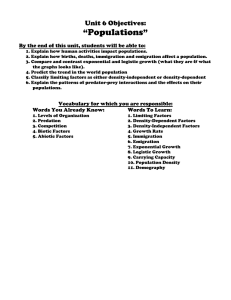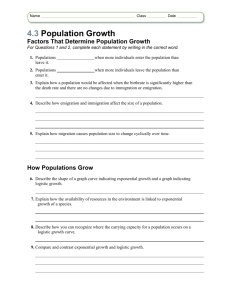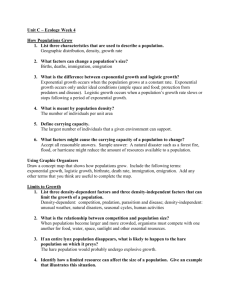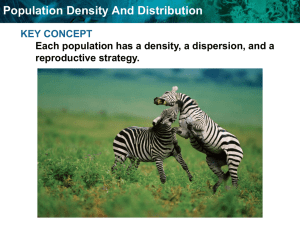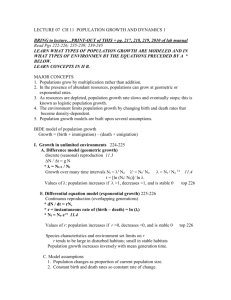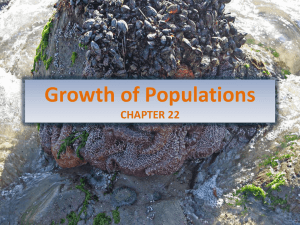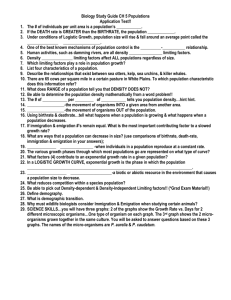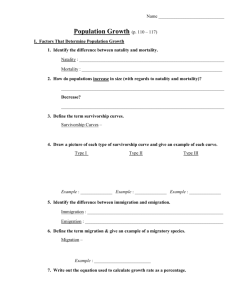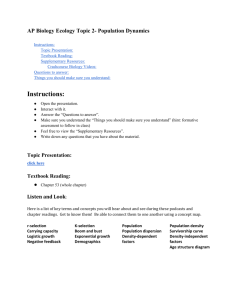Name: Pd:______ Date: Populations Due: Understanding
advertisement
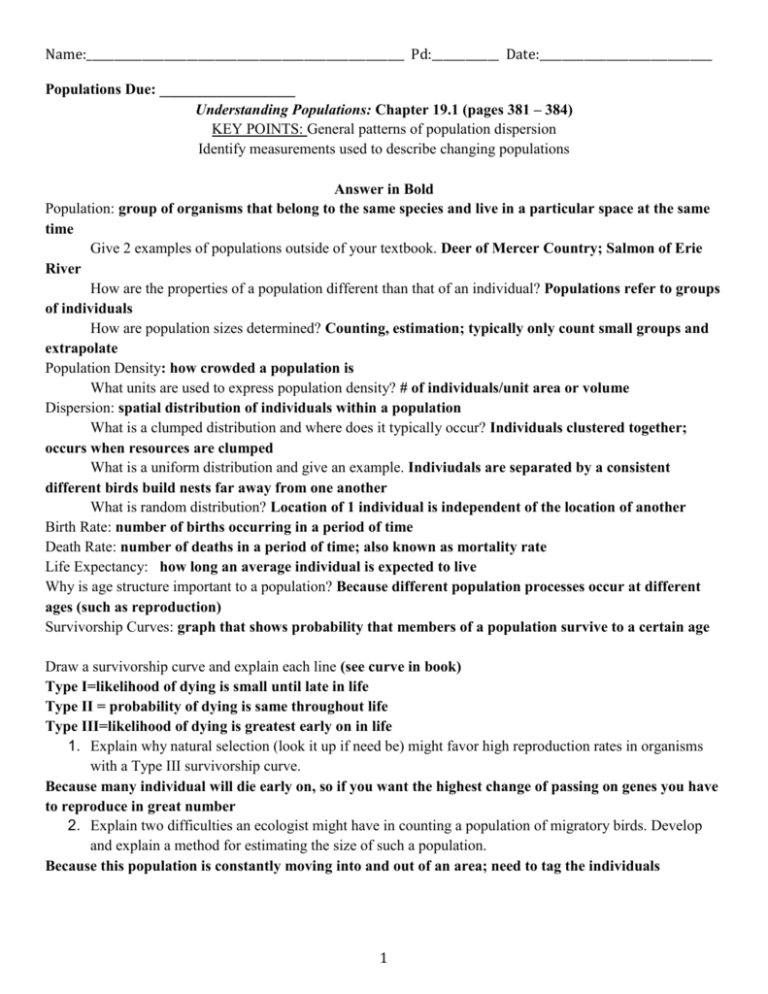
Name:_________________________________________________________ Pd:____________ Date:_______________________________ Populations Due: __________________ Understanding Populations: Chapter 19.1 (pages 381 – 384) KEY POINTS: General patterns of population dispersion Identify measurements used to describe changing populations Answer in Bold Population: group of organisms that belong to the same species and live in a particular space at the same time Give 2 examples of populations outside of your textbook. Deer of Mercer Country; Salmon of Erie River How are the properties of a population different than that of an individual? Populations refer to groups of individuals How are population sizes determined? Counting, estimation; typically only count small groups and extrapolate Population Density: how crowded a population is What units are used to express population density? # of individuals/unit area or volume Dispersion: spatial distribution of individuals within a population What is a clumped distribution and where does it typically occur? Individuals clustered together; occurs when resources are clumped What is a uniform distribution and give an example. Indiviudals are separated by a consistent different birds build nests far away from one another What is random distribution? Location of 1 individual is independent of the location of another Birth Rate: number of births occurring in a period of time Death Rate: number of deaths in a period of time; also known as mortality rate Life Expectancy: how long an average individual is expected to live Why is age structure important to a population? Because different population processes occur at different ages (such as reproduction) Survivorship Curves: graph that shows probability that members of a population survive to a certain age Draw a survivorship curve and explain each line (see curve in book) Type I=likelihood of dying is small until late in life Type II = probability of dying is same throughout life Type III=likelihood of dying is greatest early on in life 1. Explain why natural selection (look it up if need be) might favor high reproduction rates in organisms with a Type III survivorship curve. Because many individual will die early on, so if you want the highest change of passing on genes you have to reproduce in great number 2. Explain two difficulties an ecologist might have in counting a population of migratory birds. Develop and explain a method for estimating the size of such a population. Because this population is constantly moving into and out of an area; need to tag the individuals 1 Name:_________________________________________________________ Pd:____________ Date:_______________________________ 3. Which patterns of dispersion does the global human population have? Clumped-live close to resources Measuring Populations: Chapter 19.2 (page 385 – 389) KEY POINTS: Identify four processes that determine population growth Exponential model versus logistic model Density-dependent versus density-independent Explain why populations are more vulnerable to extinction Growth Rate: amount by which a population changes at a given time What four processes can affect growth rate? Growth, death, immigration, emigration Immigration: movement of individuals into a population Emigration: movement of individuals out of a population What assumption do demographers usually assume? Immigration = emigration How is growth rate calculated? Growth rate = birth rate – death rate Birth rate = number born/total population; Death rate = number dies/total population Set up a sample calculation and label everything. (see powerpoint) Exponential Growth: pattern of increase in number of individuals with each generation Draw and label a graph (see book) What shape graph is this going to make? J-shape What is the key factor to a population having exponential growth? Unlimited resources In a natural environment what would keep a population from having exponential growth? Limiting factors Logistic Model: birth rates decline and death rates rise as population grows What does the logistic model take into account? Limiting factors What is the carrying capacity (K)? number of individuals an environment can support over a long period of time Draw and label a graph (see book) Density-independent factors: reduce population by same proportion regardless of population size Explain an example outside of your textbook: hurricane, flood, fire, precipitation, volcano Density-dependent factors: limitations triggered by increasing population density Explain an example outside of your textbook: disease, parasites, food source, predation How did the Lynx and Snowshoe hare population fluctuate? Peaks in both population arose around the same time and were followed by decrease in population size 4. Explain how inbreeding can threaten the survival of a small population? Leads to less variation which makes adaptation to a changing environment harder. 5. What type of limiting factor is a disease that is transmitted by parasites? Density-dependent because parasites are more likely found in density-dependent because parasites thrive in densely populated areas. Without multiple hosts a parasite cannot thrive. 2 Name:_________________________________________________________ Pd:____________ Date:_______________________________ 6. What unknown factors might make it hard to predict the future size of the human population of a country? We do not know how fast our limiting factors will decrease, we can only make estimations. Human Population Growth: Chapter 19.3 (page 390 – 392) KEY POINTS: Explain how the development of agriculture changed the pattern of human population growth Describe changes in human population size in the past 10,000 years Compare patterns of population growth in developed versus developing countries. Hunter-gatherer lifestyle: hunting animals and gathering plants to obtain food How was studying these populations helped scientists? Scientists learn that a low rate of population growth is due to small starting populations and high death rates. Agricultural revolution: When humans began to cultivate plants and domesticate animals for food How did this affect humans? Led to increased growth rate Why did the human population accelerate after 1650? There was a sharp decline in death rates because of better sanitation and disease control. There was also more available money and food. Why did population growth rates increase again after WW2? There were more improvements in health and human hygiene, especially in poorer countries. What percentage of humans live in developed countries? 20% What percentage of humans live in developing countries? 80% What is the demographic transition model? Industrial development leads to economic and social progress which affects population growth rate. 7. How might vaccines against disease affect population growth rates? Vaccines decrease death due to disease, so population increases. 8. How is it possible for some countries with low birth rates to have high rates of population growth? Because the individuals have long life expectancies, low death rates, and there is a high level of immigration. 3
